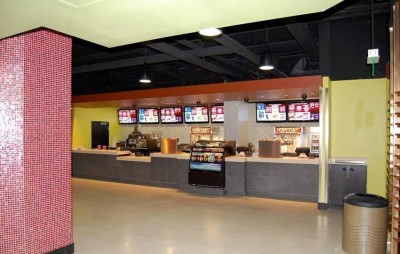The back room
As mentioned, using media signal extension and distribution equipment enables media players to be installed far away from the public space, in an environmentally controlled room, where they will be more secure.
So long as the appropriate employees can enter this room, the challenges of accessibility are significantly reduced. There is no need to disturb a shop’s customers for hardware repairs. Storage is easier. And with all of the screens’ media players mounted on the same rack, upgrades and servicing can be accomplished within minutes, rather than hours.

Sandwiching a media player between a screen and a wall can also prove problematic for regular servicing and upgrades.
When a problem crops up, it can be fixed immediately. Work can be carried out during regular daytime hours, rather than waiting until nighttime when service costs may be doubled or tripled.
There should also be less frequent need for servicing, with the hardware investment protected. The temperature-controlled room will prevent the players from overheating and keep them dust-free, so they will not break down as quickly as players located at screens.
Further, in many cases, the installation charges are the same, because the same cabling that would be used to bring data to a screen-mounted player can be used for media signal extension and distribution purposes.
As the audiovisual (AV) industry continues to transition from analogue to digital data distribution systems, however, the technology choices can become difficult. There are three basic choices for media signal extension today:
- Older analogue Video Graphics Array (VGA) hardware, which tend to be more cable-friendly than newer digital options and can cover longer distances.
- High-definition Base T (HDBaseT) connectivity, which uses a specific chip set to enable the transmission of uncompressed HD video, stereo audio, bi-directional RS-232 serial binary single-ended data and control signals, 100-MB Ethernet signals, some control signals and electrical power, all through the same single cable. HDBaseT extenders require shielded Cat6 cable for optimal performance and are limited to 330 m (100 ft) in distance. A newer version of the chip set allows for longer distances, but only by eliminating the control signals and losing some of the HD video colour depth.
- Internet Protocol (IP) streaming technology, which can disseminate content to more than one screen. These systems tend to use either the H.264 video compression format or the Joint Photographic Experts Group 2000 (JPEG 2000) image compression standard and coding system.
Taking a position
In these ways, the question of where to position media players for a digital signage network entails significant ramifications, including both capital and operating expenses. The best choice for connectivity will depend on the environment in which the network is being deployed, but for the most part, removing media players from screens and storing them in a centralized location will save time and money.
David Haar is vice-president (VP) of digital signage solutions for Kramer Electronics, which develops, designs, manufactures and markets Minicom digital signage hardware. He will present a seminar titled ‘Distributed Versus Centralized Player and Connectivity Architecture in Dynamic Digital Signage Design’ at the next Digital Signage Expo (DSE) in Las Vegas, Nev., on February 13, 2014, based on the Minicom white paper, ‘Cost Ramifications of Player Placement in Digital Signage Networks.’ For more information, visit www.minicomdigitalsignage.com; and to register for DSE 2014, visit www.dse2014.com.





